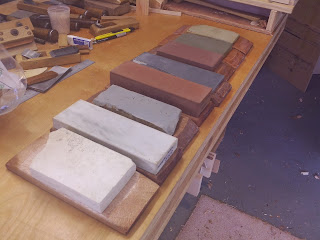They aren't lined up for a photo op, there is actually a greater purpose at work here.
I sunk some holes and filled them with silicone to act as non-skid.
Why is it that silicone is so contrary, sticking where you don't want it, but when you do want it to stick....
I first tried wax paper, no love there. I thought about poly-ethelene sheet, but decided to give this a shot. I waxed the work surface about 5 times and the stuff STILL didn't want to let go. Only 2 pads popped out. The silicone has a bit of wiggle to it that I might find too objectionable, though. We'll see.
I roughed out some stock for the toolbox project...
The pile on the left is what I got planed before I decided to stop. The kanna were a bit dull to begin with, due to planing a bunch of black walnut the other day. Time to sharpen!
55mm, 65mm, 72mm or so.
This is the progression that I use, from left to right, thick to thin cut. Secondary blades are not in place for the photo and the one in the middle? That one I am still trying to figure out. It's only set for 1 blade right now and I may keep it that way. I just need to tighten up the throat.
Different dai thickness's.
The middle kanna is a bit of an oddball. The dai is thinner, not from use, it was just cut that way. The wood used isn't the usual red or white Japanese oak. Examples of those species happen to be on either side. The grain is completely different and the feel is very dense. It shows a very attractive ribbon pattern with ray flecks and for whatever reason seems very tiring to hold and use for any amount of time. This might be due to the thinner/lower height, but I've got other kanna made of white oak that are just as thin and are not tiring..... Strange. The "pull" is a bit higher, but it does cut well and the iron is very easy to sharpen and holds an edge pretty well.
You can see from the height of the urasuki (the back hollow) that this blade is practically brand new.
This blade was laminated using lots of steel, what kind.... I wish that I knew. It is REALLY easy to sharpen, but holds a good sharp edge. In comparison, the blade on the right will last for generations, it's that hard. For all I know, it already has.
Nice ren-tetsu kanna blades.
Easy to sharpen------>hard
The stones are out, might as well do a few extras. The relative ease at which these different blades sharpen is remarkable. The tiny 28mm kanna blade on the left is super easy to sharpen and actually holds an edge well. It fits a (probably) cheap kanna that took a lot of work to make functional but now is a favorite. The blade on the right holds a great edge but is a b***h to sharpen. It has a circle stamp on it that I "think" indicates a special type of aogami steel.
The chisel....... ohhhh, my poor little chisel. This 24mm is a joy to sharpen, gets RAZOR sharp and works wonderfully for paring things flush. It had a lot of hand forged character and is well made...... but was tempered a bit too high, making it soft. Cutting anything harder than pine causes the edge to fold.
A tool that is too hard is very bad and will chip and shatter at the edge, but I actually LIKE that situation. That means that I can draw the temper myself and get the steel just the way I want it.... JUST soft enough to hold an edge without chipping. Right now I choose edge retention at the expense of ease in sharpening, but maybe this will change in the future. This chisel is TOO soft and it wouldn't be right to sell something that doesn't work to it's potential.... This one needs to go back into the forge to be re-hardened. Not today, though. I've got more wood to plane.
I cut some of the thinner POCedar to use for drawers and such. I started to plane it down and it felt as though the tools were fighting me, the wood was tearing out, nothing felt right. I went back and cut a bunch more wood on the tablesaw so I would have extra for other projects and this time, when I used the planes, things worked well. This is the stuff that is soooo hard to learn, to listen to your inner-self and KNOW that you are doing something wrong. If I had continued, I would probably still be at it NOW, so I figure that I actually saved time by shifting gears. I know that I did a better job.


















































